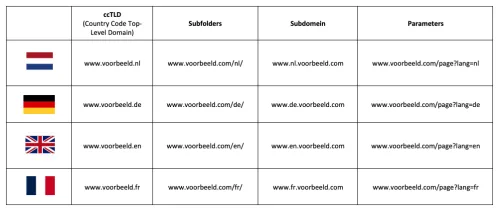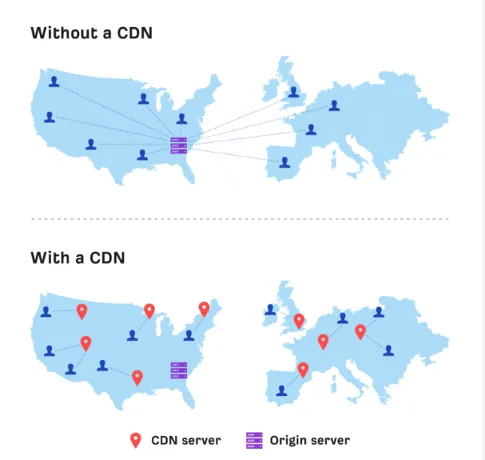Planning a good international online marketing strategy almost always involves SEO issues, often in combination with technical hurdles or choices that need to be made. Should you choose a www.example.com/de/ URL structure or a www.example.de domain? In this article, we guide you step by step to make the right choices for optimal international visibility.
Choosing URL Structure
When the desired countries are clearly identified, the URL structure is often one of the first things for the website/webshop where a choice needs to be made. There are various options available (see the table below):

ccTLD
Advantages:
-
- Clear geotargeting
- User Experience (When someone lives in Germany and also uses a German browser, they are generally more inclined to click on a .de domain)
- The server location is irrelevant
- Geotargeting within Google Search Console happens automatically
- Local hosting possible for improved page load time
Disadvantages
-
- More expensive, as multiple extensions need to be purchased (.nl, .de, .fr, etc.)
- When expanding to other countries, the domain name may already be claimed and unavailable
- More server infrastructure needed to maintain various domains
- URL provides no information about the language (.ca can be for both French and English speakers)
Subfolders
Advantages:
-
- Easy to set up and also easy to add countries/languages
- Geotargeting within Search Console is possible
- Low maintenance
- Segmentation by language is possible (e.g., /nl_BE/ for Dutch-speaking Belgians and /fr_BE/ for French-speaking Belgians).
Disadvantages:
-
- Users are generally less familiar with the URL structure
The subfolder structure is often popular among SEO specialists and web developers because it is easy to set up and maintain. However, it is always custom work, and subfolders are not always the best choice for every business. For example, if a website has been running on a .nl domain for 10 years and is well visible within Google Netherlands, it may be wise to choose .com/de/ and .com/fr/ when expanding to Germany and France, but retain the Dutch .nl domain. This way, it doesn't need to be migrated, which always carries a risk of losing positions. It depends on the situation, industry, and of course, the budget.
Subdomains
Advantages:
-
- Easy to set up
- Easy to keep languages separate
- Geotargeting within Google Search Console possible
- Possibility to use different server locations (regions)
Disadvantages
-
- Maintaining various domains can be technically complicated
- Users are not familiar with the URL structure, .com says nothing about the language
URL Parameters
Advantages
-
- None
Disadvantages
-
- Segmentation based on URLs not possible
- No geotargeting in Search Console
- Users do not recognize the URL structure
In short, the subfolder or the ccTLD is almost always the most suitable option. Depending on the situation, a choice is often made for either a subfolder structure or a ccTLD structure.
Install a CDN (Content Delivery Network)
Everyone knows by now how important Core Web Vitals are today, not only for website rankings but also for user experience and conversion rates. When using CDNs, users load a page from a local server instead of a central server. This benefits the page load time and thus the user experience.

Conduct Keyword Research Abroad
Conducting keyword research in another language can be challenging. Other countries may use completely different synonyms to search instead of a literal translation from Dutch. For example, our southern neighbors (Flanders) search for ‘frigo’ or ‘ijskast’ instead of ‘koelkast’. Therefore, always use data from competitors who are already well visible abroad. Run the relevant competitors through an SEO tool like Ahrefs, Semrush, or Majestic, and based on this data, a menu structure/content plan can be developed per product category or service.
Local Aspects per Language Version
Users expect all elements on a website to be displayed in the language of the respective country. A German visitor expects the entire website to be displayed in German, including the URL structure, main navigation, content, ordering process, etc. For example, if the URL structure in Germany is still built with Dutch URL slugs, this is not only harmful to SEO but also to the website's reliability. After all, one expects German URL slugs on a German domain:
Incorrect URL slug: https://www.example.com/de/broeken/rood/
Correct URL slug: https://www.example.com/de/hose/rot/
Also, consider elements such as:
- Currency
- Time zones
- Phone numbers (when possible)
- Address details (when possible)
Someone in the United Kingdom expects to see pounds as the currency, not euros. The same goes for time zones. Specify this well per country; if not properly configured, it will affect reliability.
Hreflang Tag
When you mention the words ‘international SEO’ to SEO specialists, hreflang tags might be the first thing that comes to mind. Hreflang tags are essential for international websites. A hreflang tag is a piece of code in the website's source code that helps Google understand the following:
- Which language version/market the current page is aimed at
- The alternative pages of the current page for users in other countries/markets
- A default version to display for users where no language version is set up (generally the English variant)
The hreflang implementation not only helps guide users to the correct language version but also passes value between pages, often positively affecting rankings. Each language domain benefits from the authority of the other language domains. The most common way to implement hreflang tags is in the <head> of the source code:

Build Authority in Each Market
Despite the implementation of hreflang tags, the different language versions must build external authority. If the Dutch version has already built a strong backlink profile over the years, part of this value is passed on to the other language versions. Suppose a new domain has recently been set up in Germany; the backlink profile of this domain is still completely empty. To build authority in Germany, backlinks from other German domains are essential. The authority built in the Netherlands logically has much less effect in the German market, as it is a different country. A good PR/link building plan per country is therefore a necessary part of the entire international SEO strategy.
Geo-Redirects? Never Use in Combination with SEO!
With Geo-redirect, a French user is directly redirected to the French language version. Actually, that's good, you might think? Because then potential customers land directly on the correct language version.
However, there is a big problem. Google crawls from a US IP address, so the Googlebot is also directly redirected to the English language version, resulting in the other language versions not or less being crawled and indexed by Google.
Google is also clear about this:
Don’t use IP analysis to adapt your content. IP location analysis is difficult and generally not reliable. Furthermore, Google may not be able to crawl variations of your site properly. Most, but not all, Google crawls originate from the US, and we don’t attempt to vary the location to detect site variations.
Therefore, do not use Geo-redirects to guide users to the correct language version. This is also not necessary, as the language versions rank well for the correct countries themselves. Google does not show German domains for French searches in France; French domains are shown.
Conclusion
Developing an international SEO strategy can be challenging, and there is certainly no standard method. The choices depend on the objectives and the process. Additionally, costs can also influence the choice of a subdomain or subfolder. However, aspects such as hreflang tag implementation and keyword research per country are always necessary. In short, a good international SEO strategy/website structure is very important, not only for SEO but also for the reliability of your brand abroad.
Need advice on your SEO strategy? Then be sure to contact the SEO specialists at Follo.




